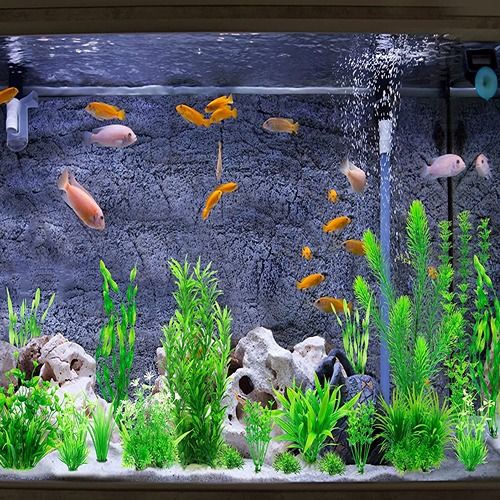Aquarium plants are essential to the well-being of your aquarium fish. Not only do they provide a place for beneficial microorganisms and food sources to grow, but they also offer hiding places for small fish and serve as visual entertainment in an otherwise sterile space.
Aquarium plants can be divided into two groups: foreground (low) and background (high). Foreground plants are those that sit directly next to the glass on driftwood, within decorations, or are planted in the substrate. Background plants should be positioned across from the front of your tank so that viewer's eyes can focus on them before looking at the rest of your aquarium setup.
Most aquarium setups include both foreground and background plants however, if you have a large tank with larger fish, you may not need as many background plants especially if you have smaller foreground varieties that will hide behind larger ones. In this case, skip ahead to our section on high-light aquariums below.
We hope you find your next favorite thing from the list below! Each product was independently selected by our editors. ConsistentReviews may collect a share of sales or other compensation from the links on this page if you decide to buy something (that's how we stay in business). We hope you find your next favorite thing!
How We Choose
We went through a lot of aquarium plant brands and varieties before narrowing down the best oxygenating plants on our list to only include those that have consistently positive customer reviews for oxygenation ability. We also looked at expert recommendations, taking into account things like the oxygenating plant's height and spread potential, as well as their suitability for different types of aquarium setups and aquatic environments (community vs. species-specific).
Once we had narrowed down our list to the absolute best aquarium plants for oxygenation, we tested them out in our own personal setups! We started by setting up simple community tanks with just one type of plant and one type of fish; then, we gradually added more elements (different types/colors/shapes of fish/shapes of plants/shapes of the bottom incorporating oxygenating plants/plant of high yielding oxygenating plants) until we had an aquascape that was diverse but still looked beautiful.
While some plants definitely performed better than others overall, it quickly became apparent that there are no best plants for all situations - instead, you need a variety of options so you can find one(s) that work best in your specific setup!
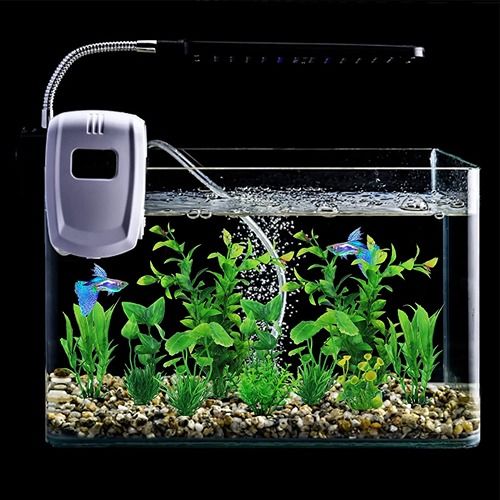
PietyPet Fish Tank Accessories Aquarium Decorations Green Plants
Best Aquarium Plants for Oxygenation
Why We Love It
The PietyPet 10-piece aquatic plant and set is a great way to add some green life to your planted tank. The plastic plants are made of soft and healthy material, with no harm to water or fish.
What You Should Know
These plants are ideal for both freshwater and saltwater aquariums, as they won't affect the PH in the tank. They come with pedestals at the bottom so that those plants will not float around in your own cold water aquariums water. The leaves on the stem plant these oxygenating plants are also very soft which helps to fish healthy, so your fish can easily get used to having them in their home without any harm being done.
They're perfect for adding some greenery to your setup without taking up too much space or costing a lot of money - which is always a plus!
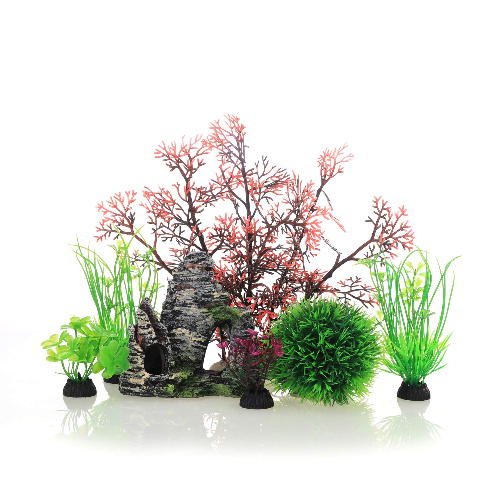
JIH Aquarium Fish Tank Plastic Plants and Cave Rock Decorations Decor Set 7 Pieces
Best Aquarium Plants for Oxygenation
Why We Love It
The JIH Aquatic Rock is a fantastic addition to your aquarium for the proper growth of your aquatic pets. Its natural-looking texture creates a stimulating and comfortable environment for your fish health, which is essential for their health and well-being.
What You Should Know
The rock's lightweight and realistic design makes it easy to move around and reposition, allowing you to create a new and exciting layout for your tank. The cave inside the rock provides an excellent hiding spot for your fish, which can help to reduce stress and promote healthy behavior.
Overall, the JIH Aquatic Rock is an excellent investment for anyone looking to create a natural and healthy aquarium environment for their aquatic pets, promoting proper growth and health for your fish.
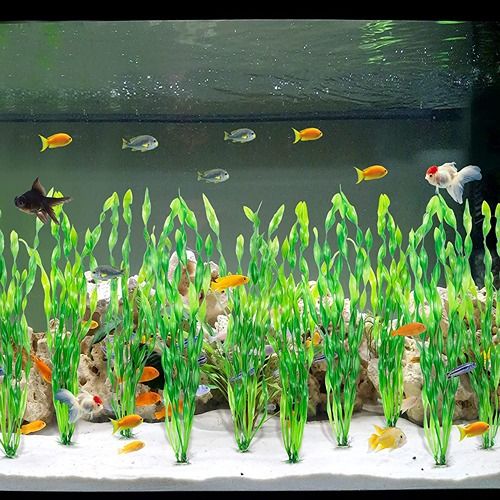
MyLifeUNIT Artificial Seaweed Water Plants for Aquarium
Best Aquarium Plants for Oxygenation
Why We Love It
The MyLifeUNIT Artificial Seaweed Water Plants for Aquarium decorations are an excellent choice for ensuring the optimal growth of your aquatic pets and aquatic flora. Unlike live aquatic plants, they won't overgrow or compete for space in your tank, providing a hassle-free and convenient solution for aquarium decor.
What You Should Know
These artificial plants are eco-friendly and non-toxic, with a PVC and ceramic base that won't harm your fish or contaminate the water. They're also long-lasting and won't fade over time. While the round shape of these plants may not be ideal for algae growth, they are perfect for maintaining the proper growth and health of your fish by not overcrowding the tank. You can easily use them to create a stimulating and visually appealing environment for your aquatic pets.
Overall, The MyLifeUNIT Artificial Seaweed Water Plants for Aquarium decorations are an excellent investment for promoting optimal growth and a comfortable living environment for aquatic organisms and your fish, without the hassle of live plants.
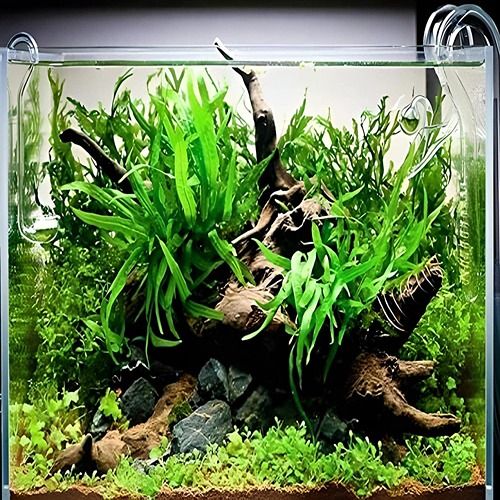
Java Fern Bare Root | Microsorum Pteropus - Low Light Freshwater Aquarium Plant
Best Aquarium Plants for Oxygenation
Why We Love It
The AquaLeaf Java Fern is a great option for anyone looking to add a touch of nature to their aquarium. This versatile plant is easy to care for and can be left in any type of aquarium, regardless of its size or shape.
What You Should Know
The leaves and stem plants are soft and delicate, making them perfect for adding texture to your tank. The stalks also have small nodules that look similar to coral, which adds an extra layer of realism if you're into that sort of thing. This plant grows naturally in the aquarium water with low levels of nutrients, so it's important not to overfeed it or let the water become too dirty.
Once established, this fern will require minimal maintenance and should last for years without any issues. It's a great addition to any home aquarium set-up and can help bring out the natural beauty in your fish as well as add some much-needed greenery!
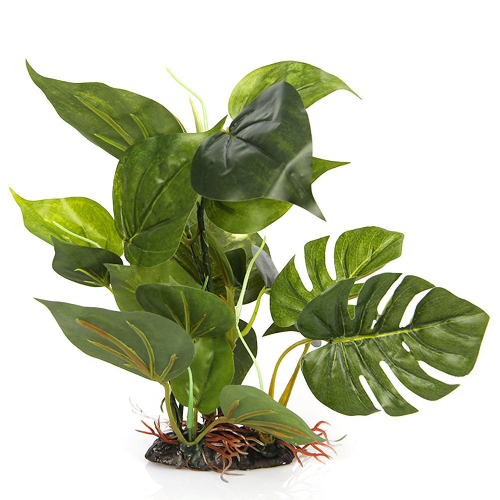
CNZ® Aquarium Fish Tank Green Lifelike Underwater Plastic Plant Aquatic Water Grass Decor
Best Aquarium Plants for Oxygenation
Why We Love It
The CNZ Lifelike Aquarium Plastic Plant is a great way to add life to your tank. This ceramic plant is made from plastic and ceramic materials, making it both durable and realistic-looking.
What You Should Know
The leaves are green in color, with small holes throughout that allow water to drain through so the plant looks more natural. The weight of the base anchors it in place so you don't have to worry about it moving around while you're setting up your aquarium or while you're adding new plants later on down the line.
It's not too big either, which makes it easy to fit into any size aquarium without taking up too much space or looking out of place. It comes in multiple colors as well so you can find one that matches your décor perfectly if you have a matching setup going on in your room.
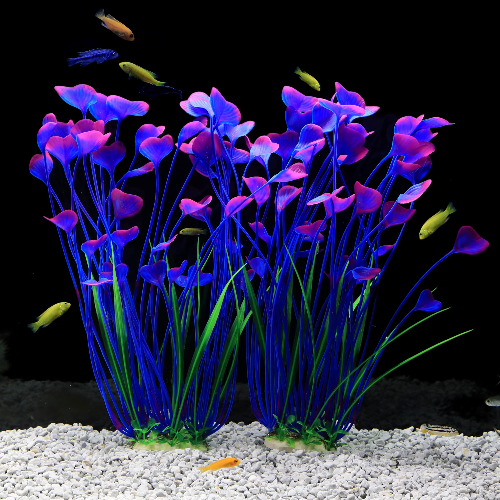
JIH Plastic Plants for Aquarium, Tall Artificial Plants for Fish Tank Decor
Best Aquarium Plants for Oxygenation
Why We Love It
These plants are perfect for adding a splash of nature to your home aquarium. They're not real plants, but they look like they could be!
What You Should Know
They come in two different sizes so you can find the right fit for your tank. The larger size is ideal if you have a large fish tank, while the smaller one works better for tanks that are more compact. These plastic plants will add a touch of realism to your setup and make your fish feel more at home.
They don't need any pruning and will stay beautiful season after season, so you can enjoy their company every day without worrying about maintenance or dead plants.
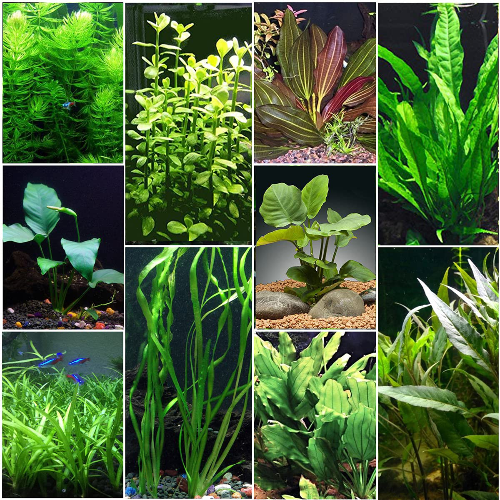
Florida 10 Species Live Aquarium Plants Bundle
Best Aquarium Plants for Oxygenation
Why We Love It
The AquaLeaf Aquatics plant substrate is a great choice for anyone looking to add some aquatic life back to their aquarium. These plants are designed to absorb waste and provide a natural habitat for your fish and invertebrates.
What You Should Know
The substrate is made from peat moss, sand, and volcanic rock, which helps to filter water and keep your tank clean. It also provides a place for plants to grow that's free of gravel or other harmful materials. The product comes with 10 different plant species, so you can experiment with different looks in your tank.
We recommend this product if you want to add some greenery without having to worry about maintenance or upkeep. However, it does require regular watering, and water temperatures so be sure not to skip any scheduled or water temperature changes when using this product.
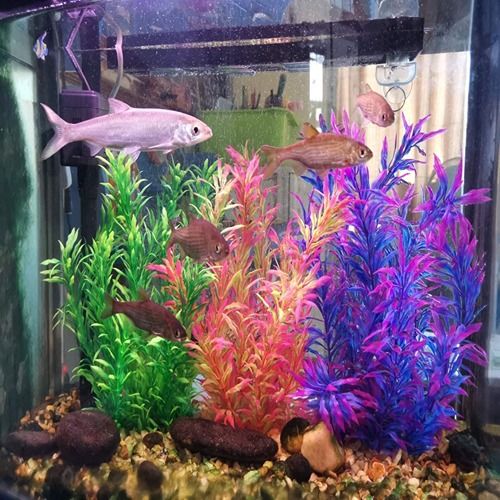
QUMY Large Aquarium Plants Artificial Plastic Fish Tank Plants Decoration Ornament for All Fish
Best Aquarium Plants for Oxygenation
Why We Love It
The QUMY Aquarium oxygenating plants are a great option for anyone looking to add some life to their tank. These oxygenating plants come in several different varieties, each with its own unique shape and color.
What You Should Know
They're made from plastic, so you won't have to worry about them dying or becoming unattractive over time. They don't need any special lighting either, which makes them easy to care for and perfect for beginners. Just make sure they get enough light, as low light can lead to poor growth and hinder their proper growth and development.
These oxygenating plants are ideal for adding some life and variety to your aquarium without taking up too much space or requiring much maintenance. They look great floating around the bottom of the tank, making it feel more natural and lifelike than other types of plant ornamentation.
Why We Love It
The MyLifeUNIT Plants are an affordable option that delivers on their promise of lifelike realism. These artificial plants come in a variety of shapes and sizes, from tall palm-like specimens to delicate ferns, making them suitable for a wide range of fish tanks.
What You Should Know
The thick and heavy-duty ceramic bases are stable and can prevent the other plants below from floating in the water, which is great if you're looking for a more stationary display. These plants are made of reliable and soft material that won't contaminate your water or fade color over time, so they'll look good no matter what you choose to decorate your tank with.
These seaweed plants also have lifelike leaves that allow your fish to hide inside them, providing a comfortable and clean living environment for them. Unfortunately, these aren't very durable - we found some fraying after only light use - but considering how cheap these are this is understandable.
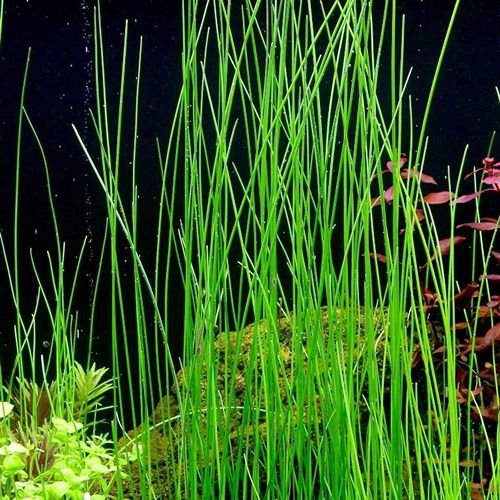
AQUARIUM PLANTS DISCOUNTS Potted Tall Hairgrass by AquaLeaf Aquatics
Best Aquarium Plants for Oxygenation
Why We Love It
Giant Hair Grass is a great oxygenating plant for any freshwater aquarium. It's an easy-to-care-for aquatic plant, that will grow naturally in your tank.
What You Should Know
It grows fast and can reach up to 18 inches tall, making it a tall plant perfect for tall aquariums. The leaves on the stem plant are 15-18 inches tall at the time of shipping, so you'll have a tall plant with plenty of room to play around with this one. It also has a natural look that makes your aquarium look beautiful.
You can cut the leaves down to any size you want, so you're free to customize it however you'd like. This potted plant will make your aquarium stand out from the rest!
Best Aquarium Plants For Oxygenation FAQs
Aquarium plants produce Oxygen which can help keep your fish healthy, but it can be tough to figure out which ones are best for you.
With all the different types of aquarium oxygenating plants out there, it's hard to know where to start shopping. Do you want good oxygenating plants or plastic ones? How do you know which ones will work best in your tank?
We've answered some of the most Frequently Asked Questions about aquarium plants below so that you can make an informed decision about which ones are right for you and your needs.
Which Plants Give Off The Most Oxygen?
In general, grasses and other plants like floating plants, submerged plants floating pond plants, and submerged pond plants that grow in water give off the most oxygen. You'll find these types of aquatic plants at your local pet store or online. Aside from being able to give off a large amount of oxygen, these types of aquatic plants produce oxygen and also don't require much attention because they float on the surface of the water. They're easy to clean and maintain, so you won't have to worry about changing their water too often either.
As for specific plant varieties that are best for giving off oxygen, we found that elodea (also called American pondweed) is one of the top choices. It's a very popular plant, easy to grow, and can thrive in almost any type of water environment. Other good options include horsetail ferns and duckweed (if you want something more exotic).
Do Aquarium Plants Help Oxygenate Water?
Aquatic plants do increase the amount of oxygen in water, however, it's important to remember that fish and other aquatic animals breathe oxygen gas. In the wild, many species of fish live in areas of pond water where there is little or no surface vegetation for them to hide among and consume oxygen. These species must adapt to living in low-oxygen conditions by only breathing adequate oxygen levels at certain times such as when they are hunting for food. Other fish species have evolved methods of releasing as much oxygen by creating large bubbles from their anuses which they use to access a greater volume of dissolved oxygen from the water around them.
Regardless, aquarium oxygenating plants and beneficial bacteria do help create pockets of higher concentrations of dissolved oxygen levels in aquarium water, which can be accessed by smaller aquatic creatures like insects and snails and other tank organisms that don't have the natural adaptations needed to survive in low-oxygen environments.
How Do I Increase Oxygen In My Aquarium?
The amount of oxygen in your aquarium tank depends on several factors, including water quality, water temperature, volume, and circulation. Ideally, you want an ample supply of fresh air coming into the tank as well as a good turnover of the water inside. You can accomplish this in several ways:
Use powerheads or other types of pumps to create movement within the tank. This causes agitation that brings oxygen into the water from the air above it. You don't want too much current, however, which can be stressful for your fish and plants. Aim for a gentle movement that shifts only a small portion of the tank's water's surface at any given time. Plants also help create surface agitation and bring more oxygen into your tank through photosynthesis; try using floating or rooted varieties to maximize this effect.
Which Plants Give Oxygen 24 7?
The first thing to note is that oxygen doesn't just magically appear in the air. It's produced through photosynthesis, and plant oxygenation which is a process used by plants and certain bacteria. Oxygen is produced in places where there are plenty of plants and water, such as wetlands or rainforests.
Plants use sunlight and carbon dioxide from the air to produce glucose and oxygen through this process, which takes place inside special cells called chloroplasts. This process also creates food for the plant by turning glucose into starch.
Which Plant Gives 24 Hours Oxygen?
The best way to get the recommended amount of oxygen into your bloodstream is by breathing more oxygen, but that doesn't mean it's easy. Our bodies only absorb a certain amount of oxygen at a time and if we overload our systems with too much air pump too much, we can pass out or even die. That's why humans need to breathe in small amounts of air over long periods of time.
Some plants are able to mimic this action and give you 24 hours' worth of oxygen all at once, which is roughly equal to what your body needs for an hour. The two most common plants used for this purpose are the water hyacinth and the Punica granatum (pomegranate tree). Both have been studied extensively and shown to work when properly prepared, but they aren't completely natural solutions with sufficient oxygen, since they're grown in specially designed facilities and don't exist in nature as far as anyone knows.
What Plant Absorbs The Most CO2?
The answer to this question depends on how you measure CO2 absorption. If we're talking about living plants, it's hard to say which one absorbs the most because that depends on factors like soil health and climate.
However, when researchers talk about the ability of non-living materials to absorb CO2, they use a test called the Kessler Cycle, which measures the amount of time it takes for gas to move through a material after being exposed to sunlight. Materials with high Kessler Cycle numbers can hold onto CO2 for longer periods of time.
The most effective materials at holding onto CO2 include amine salt solutions and zeolites, both of which are mined from the earth. However, scientists are still researching ways to create manmade materials that match or exceed these natural resources in their ability to store carbon dioxide over long periods of time.
How Many Plants Are Needed To Purify Air?
The number of plants needed to effectively clean the air in a room depends on several factors including the size of the room and the type of plant. Generally, it's best to think about coverage rather than quantity when choosing indoor greenery; one or two well-placed plants can have a more dramatic aesthetic effect than a cluster scattered around.
As far as cleaning your home's air, you'll want to consider which types of pollutants are most prevalent in your region. For example, if you live in an urban area with high levels of ozone, then it might be best to choose plants that help remove that particular pollutant such as bamboo palms and philodendrons. If you live in a rural area where there is little traffic and few factories, then maybe you don't need any plants at all!
How Many Plants Increase Oxygen?
While it's true that all plants produce oxygen, some types of plants are better at it than others plants. For example, the best options for increasing oxygen levels indoors would be plant species that are good at self-pollination. This means you won't need to worry about getting your hands dirty and having to keep up with regular watering schedules.
Some good examples of these include:
Pothos (also called devil's ivy)
Philodendron (also called leopard vine)
Agave (also called century plant)
How Many Plants Are Good For Oxygen?
It all depends on the type of plant. Non-potted plants, such as bushes and trees, are great at creating oxygen through photosynthesis. They're also better at absorbing carbon dioxide so they can help keep smog down in urban areas.
But potted plants don't do a very good job of replenishing oxygen because the roots are contained in a small pot, so there's less space for them to grow compared to non-potted shrubs and trees. Potted plants tend to create carbon dioxide instead, which isn't ideal for humans or animals who breathe but is helpful for things like cars that run on fuel made from corn.
Does Algae Produce The Most Oxygen?
Algae may not seem like the most obvious answer to "Which type of plant produces the most oxygen?", but it's actually correct! Algae don't have roots, so they don't tap into the soil for water or absorb nutrients themselves. Instead, algae live in bodies of water and filter out dissolved nutrients from the surrounding environment, producing oxygen.
When enough light is available, algae can reproduce rapidly, creating large populations that can produce a lot of oxygen through photosynthesis. In addition to producing plenty of oxygen on their own, some species of algae release exudates that stimulate the production of planktonic plants below them in the food chain. Because these smaller plants also produce a good deal of oxygen themselves, an algal bloom can significantly increase overall levels across an ecosystem.
Choosing the best aquarium plants for oxygenation is an important part of creating a healthy aquatic environment. These plants provide oxygen through photosynthesis, helping keep your tank's water clean and providing shelter for fish. They also help reduce algae growth by competing with it for nutrients in the water.
By selecting appropriate species of plant and taking care to maintain them properly, you can create an attractive and functional ecosystem in your aquarium. Consider the size, light requirements optimal growth, and nutrient availability when choosing which plants will work best for your tank setup. With proper care, your tank will thrive with plenty of oxygen-producing plants!



